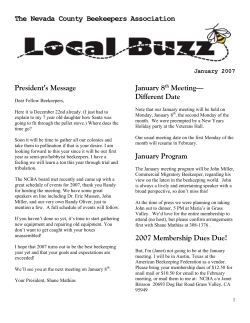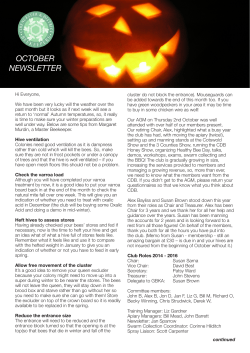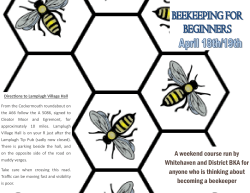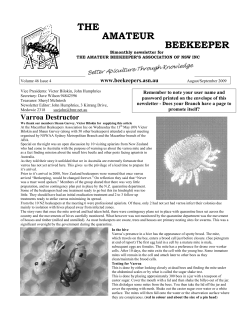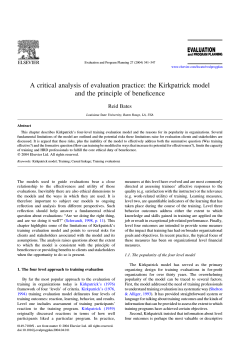
Workshop Evaluation
Joyce Thomas IT4125 March 16, 2015 Kirkpatrick’s Levels of Learning Evaluation Applied to Training for Papua New Guinea: Beekeeping: Protection from Threats Kirkpatrick’s Levels of Learning Evaluation Assignment For this exercise, I have chosen a section of the training for Papua, New Guinea: Beekeeping Protection from Threats for the evaluation. This section corresponds to one of my training objectives outlined previously. Training Goals All cooperative members will be able to accurately identify a varroa mite infestation in their hives and correctly perform a natural treatment and correctly adjust their hive structure to protect their hives. Training Objective Beekeeping: Protection from Threats Section Purpose Addresses Section Seven How to perform mite check on the bee hive. Objective 3: Learners will be able to identify if there is a threatening mite problem in their hive. Kirkpatrick Levels of Learning Evaluation Model 1. Reaction - what participants thought and felt about the training (satisfaction; "smile sheets") (Appendix A) 2. Learning - the resulting increase in knowledge and/or skills, and change in attitudes. This evaluation occurs during the training in the form of either a knowledge demonstration or test. (Appendix B) 3. Behavior - transfer of knowledge, skills, and/or attitudes from classroom to the job (change in job behavior due to training program). This evaluation occurs 3–6 months post training while the trainee is performing the job. Evaluation usually occurs through observation. (Appendix C) 4. Results - the final results that occurred because of attendance and participation in a training program (can be monetary, performance-based, etc.) (Appendix D) Cultural Considerations 1) Simple language 2) Images when possible 3) Multiple choice is too much reading Joyce Thomas IT4125 March 16, 2015 Kirkpatrick’s Levels of Learning Evaluation Applied to Training for Papua New Guinea: Beekeeping: Protection from Threats Appendix A: Kirkpatrick Level 1 Beekeeping: Protection from Threats: Section 7 Workshop Evaluation Trainer_____________________________ Trainer Date________________ Choose one number with an X 0 = not at all 0 1 2 3 5 = very much 4 5 Did the trainer speak clearly? Did the trainer know the subject? Did the trainer demonstrate well? Did the trainer ask for questions? Did the trainer answer your questions? Did the trainer stop between ideas? Was the trainer easy to understand? Class Choose one number with an X 0 = not at all 0 Did the class satisfy you? Where the pictures helpful? Was the demonstration helpful? Did you understand the steps? Could you see alright? Could you hear alright? Were you comfortable? 1 2 3 5 = very much 4 5 Joyce Thomas IT4125 March 16, 2015 Kirkpatrick’s Levels of Learning Evaluation Applied to Training for Papua New Guinea: Beekeeping: Protection from Threats Appendix B: Kirkpatrick Level 2 Beekeeping: Protection from Threats: Section 7 Learning Assessment Observation Board: 1) What can you put on the board to make it sticky? ___________________________________ 2) Is it okay to leave the board out in the sun? yes no 3) The observation board goes where? Screen Board: above the screen below the screen 4) Draw where the screen board goes on your hive Counting mites: 5) After 24 hours, is you have _____________ number of mites, there is a problem. 6) For which hive cycle are sticky boards inaccurate? Joyce Thomas IT4125 March 16, 2015 Kirkpatrick’s Levels of Learning Evaluation Applied to Training for Papua New Guinea: Beekeeping: Protection from Threats Appendix C: Kirkpatrick Level 3 Beekeeping: Protection from Threats: Section 7 Observation Form Observer _________________________________________________ Person ___________________________________________________ Sticky Observation Board Date ______________ 1) Start Time___________ End Time___________ Have the person report which cycle their hive is in. Response: 2) Ask them is this is an accurate time to use the sticky board? Response: yes no 3) Is the screen board properly placed? 4) Is the observation board properly placed? 5) What the date and time written on the observation board? yes no 6) What sticky substance was applied to the observation board? 7) How was the sticky substance applied to the observation board? Joyce Thomas IT4125 March 16, 2015 Kirkpatrick’s Levels of Learning Evaluation Applied to Training for Papua New Guinea: Beekeeping: Protection from Threats After 24 hours: Date ______________ Start Time___________ End Time___________ 8) Did the person remove the board without disturbing the hive? yes no Varroa Mite (Light brown kidney shape about 1.5 mm in length) 9) How many mites did the person count? ____________ 10) How many mites did you count? ____________ 11) Did the person think that there is a mite problem? yes no 0-3 Mites counted - Your hive is probably very healthy and cause for concern for varroa mites is low. 3-15 Mites counted - This would be a typical result, and most likely indicates a healthy hive with a minor varroa infestation. 15-40 Mites counted - A mite count this high indicates that the colony is struggling with a significant infestation of varroa. More than 40 Mites counted - A colony that drops this many mites in 24 hours is severely infested with varroa. Joyce Thomas IT4125 March 16, 2015 Kirkpatrick’s Levels of Learning Evaluation Applied to Training for Papua New Guinea: Beekeeping: Protection from Threats Appendix D: Kirkpatrick Level 4 Beekeeping: Protection from Threats: Section 7 Results Evaluation Monitoring and the correct determination of a varroa mite threat has supported a program of early treatment of this threat. Early treatment benefits: 1. Natural solutions are more effective 2. Less spread to other hives 3. Reduced loss of brood. The beekeepers in the collective have been regularly performing mite sticky board observations for a period of six months and basing their treatment options on the results. The health of the hives have increased by 20% and no hives have been lost to the varroa mite.
© Copyright 2025



